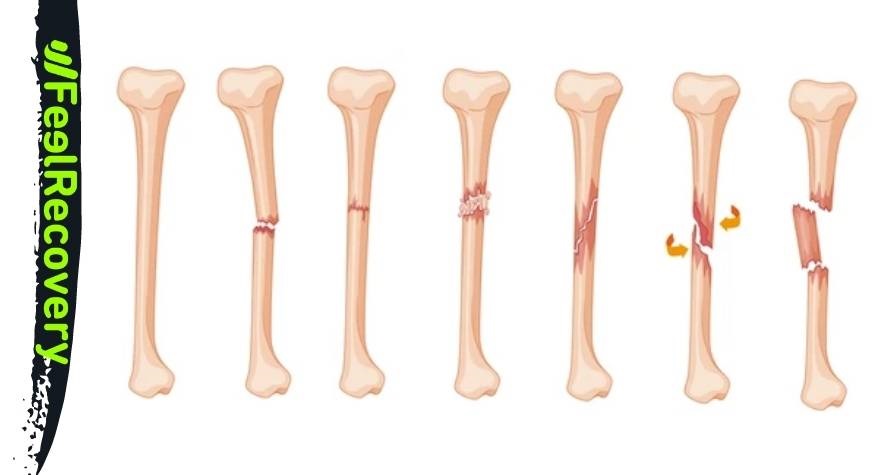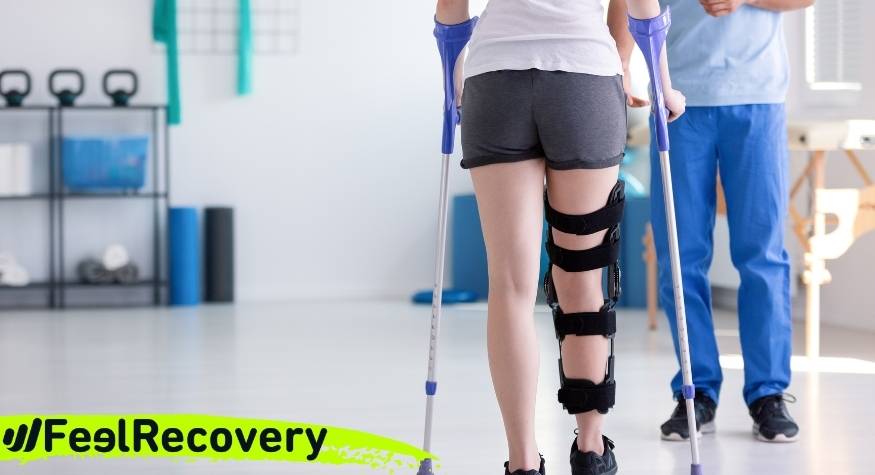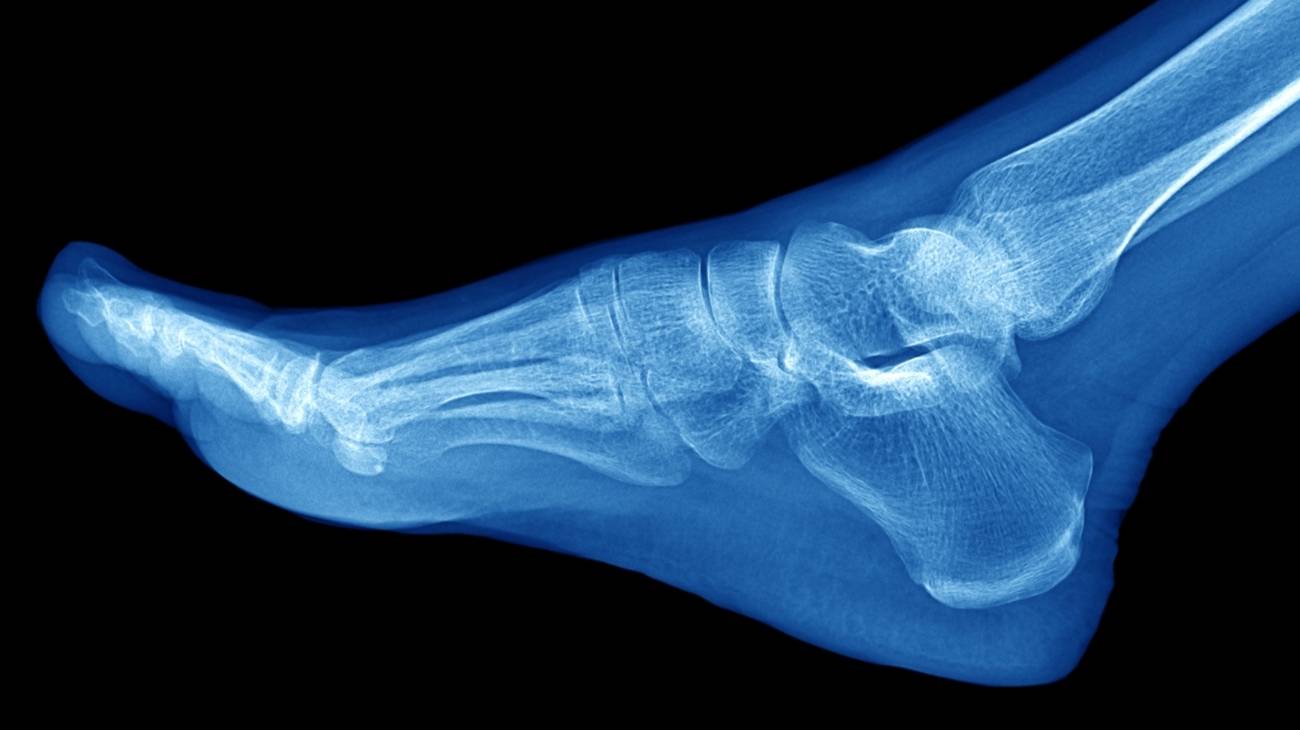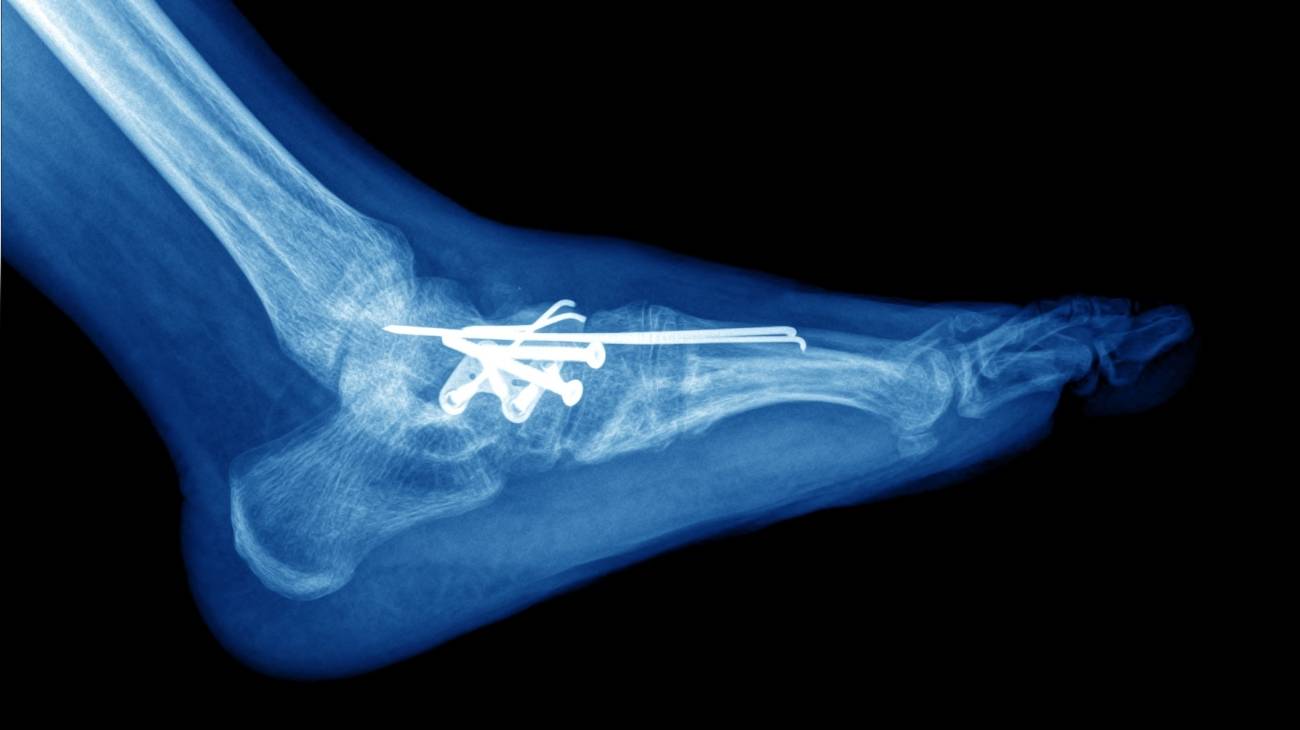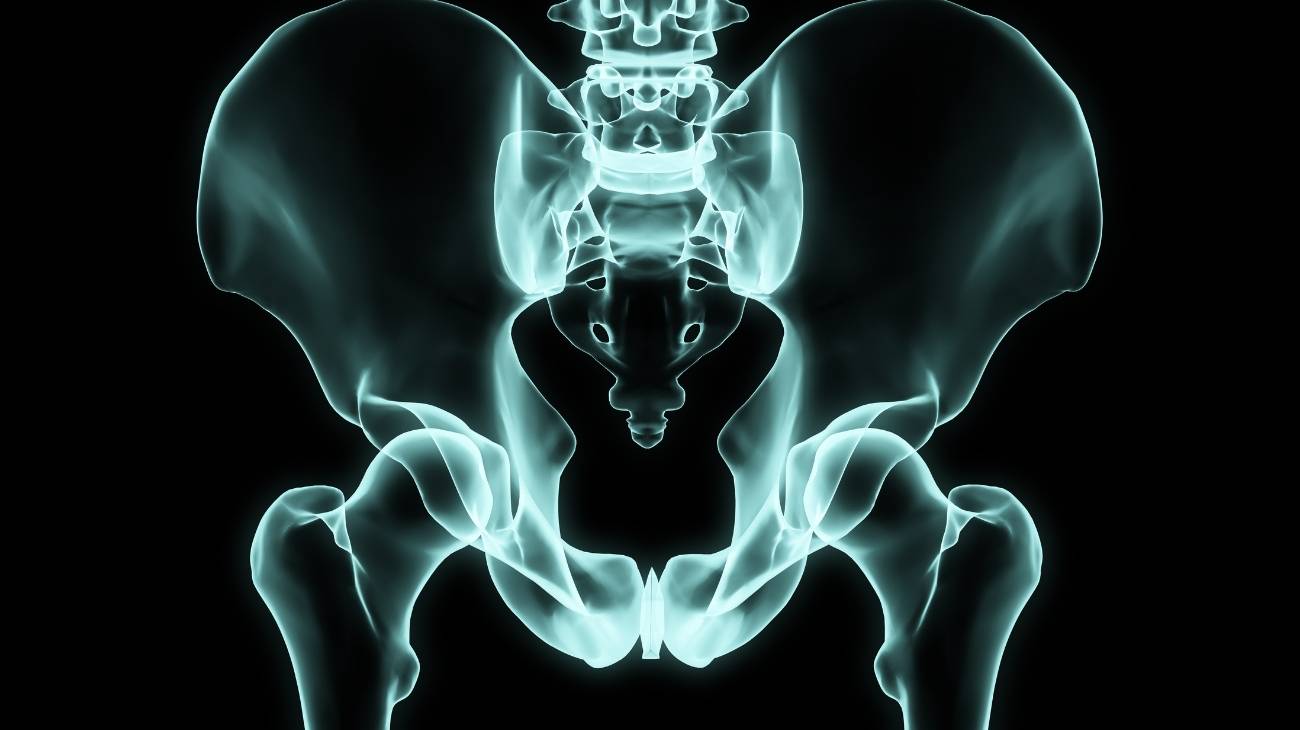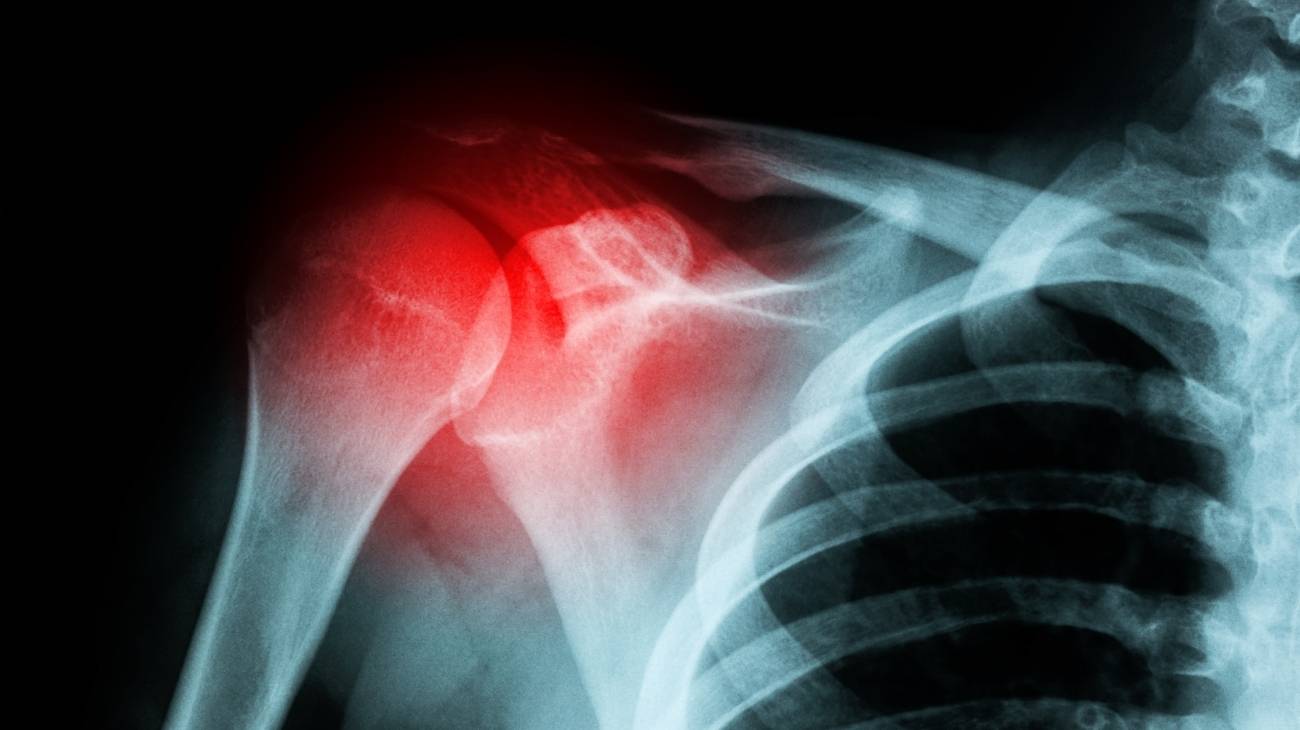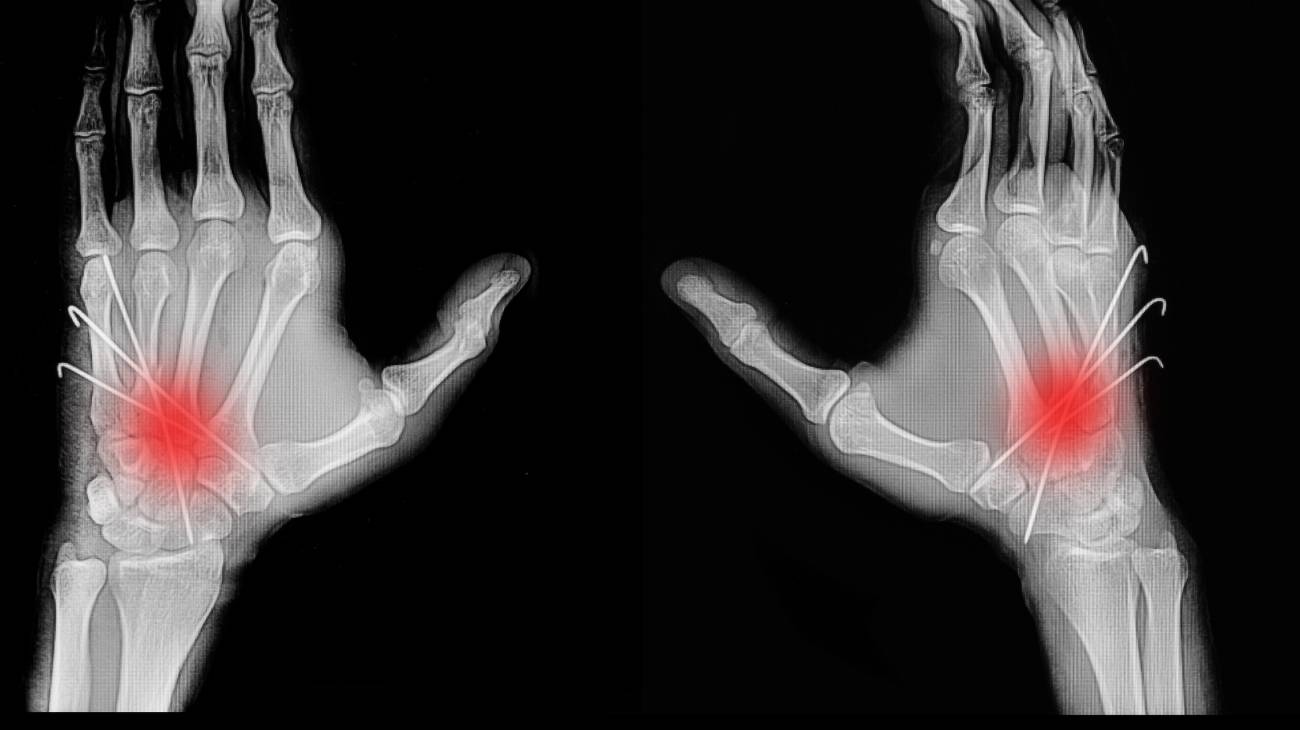- What is a leg bone fracture and how is it diagnosed?
- What types of leg bone fractures are there?
- Best products for leg fractures
- What are the causes and risk factors for leg fractures?
- First aid care for treating a leg fracture
- Most indicated treatments for a leg fracture
- Rehabilitation after a broken leg bone
- Preventive methods to avoid broken leg bones
Basically, a fracture is defined as the loss of continuity of a bone or cartilage and occurs when a portion of a bone breaks or cracks. Because the legs have three main bones, this is one of the most common parts of the body to fracture.
As such, leg bone fractures are one of the most common cases and are distinguished as a difficult condition to treat. For this reason, it is interesting to learn more about what these types of injuries are, how they are diagnosed, what causes them, what should be done to treat them and the methods that exist to prevent them.
What is a leg bone fracture and how is it diagnosed?
In specific terms, a leg fracture or broken leg is a type of injury in which the bones of the affected limb are cracked or broken.
It is a break that may involve one or more of the three long bones located in the legs, which are:
- Femur: The femur is located at the top and connects the bones of the lower leg to the pelvic bone. That is, the knee joints with the hip joint, respectively.
- The tibia: It is considered one of the longest bony portions of the human body that forms the skeleton of the leg and runs from the ankle to the knee. Thus, it has the function of providing stability and support to the body.
- Fibula: Together with the tibia, this bone forms the leg from the knee to the ankle or lower region. It is therefore supported by the tibia and also provides stability to the ankle, as well as supporting the muscles of the leg. This is the smallest of all and is located in the lower region.
The main symptoms in most cases, are:
- Pain and swelling in the leg.
- Increased pain intensity with movement.
- Tenderness to touch
- Ecchymosis or bruising
- Deformity or shortening of the impacted limb.
- Inability to walk and bear weight on the side of the injured leg.
- Inability to move the knee or hip on the injured side.
Once the physical examination is completed, it is pertinent to carry out an imaging evaluation to identify the specific fracture site and to define the extent of the injury to any adjacent joints. This is usually done by radiographs or X-ray tests which, in addition to simplifying the confirmation of the diagnosis, help to establish the detailed characteristics of the bone break.
In addition to this, it is sometimes advisable for the health professional to resort to other types of more detailed examinations in order to make the diagnosis much more concise. These tests are basically computed tomography (CT) scans or magnetic resonance imaging (MRI) of the leg.
What types of leg bone fractures are there?
In order to establish an optimal treatment after suffering a fracture in these extremities, first of all, it is necessary to detect what type of bone breakage has occurred in the extremity.
The main classification is based on which bone has been affected:
- Femur fracture: This is, of course, a break that impacts the femur, which is the thigh bone at the top of the leg. As the strongest and longest bone in the body, it tends to generate a sharp pain that varies depending on how the break occurs through the bone, what the exact location is and whether skin and muscle are also affected. In most cases, it requires surgical intervention to heal.
- Tibial fracture: This is defined as one of the most common bone fractures and is caused by high-energy impacts (e.g. road traffic accidents, traffic accidents or sports injuries). This type of injury, in turn, is classified into three subgroups, which are: Fracture of the tibial diaphysis, fracture of the proximal extremity and fracture of the distal extremity of the tibia (or ankle fracture).
- Fibular fracture: Occurs in the thin, lateral bone between the knee and the ankle, i.e. the fibula. In this case, the main symptoms manifested by the patient are the impossibility of supporting the foot due to pain, inflammation and functional impotence. It is even possible that the fracture causes a clicking sound when trying to move this part of the limb. In reference to its treatment, this is defined depending on the dimension of the injury and therefore, it can be orthopaedic or surgical.
On the other hand, depending on the leg fractures, another classification of interest is also distinguished which encompasses the following types based on the particularities exhibited by the bone fracture:
- Closed fracture: This is a type of break in which the surrounding skin of the area remains intact.
- Exposed fracture: In this case, the broken bone pierces the skin and is therefore more aggressive because of the likelihood of contracting a condition.
- Complete fracture: This is a type of fracture in which two or more fragments of the bone are broken.
- Incomplete fracture: In these cases, the affected bone shows a separation, but has failed to disintegrate into two parts.
- Green stem fracture: This refers to an injury that causes the bone to crack, but the bone does not break completely. Most patients with this type of fracture are children, as they have softer and more flexible bones than adults.
- Displaced fracture: This is a fracture in which the bony portions of each side of the break are not aligned. In order to bring the bones back into proper alignment, the person requires surgery
Best products for leg fractures
Bestseller
-
2 Calf Compression Sleeve (Black/Gray)
$19.95 -
2 Calf Compression Sleeve (Green/Navy)
$19.95 -
2 Calf Compression Sleeve (Pink/Bordeaux)
$19.95 -
2 Knee Compression Sleeve (Black/Gray)
$19.95 -
2 Knee Compression Sleeve (Green/Navy)
$19.95 -
2 Knee Compression Sleeve (Pink/Bordeaux)
$19.95 -
2 Patella Knee Strap (Black/Gray)
$14.95 -
2 Patella Knee Strap (Green/Navy)
$14.95 -
2 Patella Knee Strap (Pink/Bordeaux)
$14.95 -
2 Thigh Compression Sleeve (Black/Gray)
$19.95 -
2 Thigh Compression Sleeve (Green/Navy)
$19.95 -
2 Thigh Compression Sleeve (Pink/Bordeaux)
$19.95 -
Acupressure Mat and Pillow (Black/Gray)
$49.95 -
Acupressure Mat and Pillow (Green/Navy)
$49.95 -
Acupressure Mat and Pillow (Pink/Bordeaux)
$49.95 -
Acupressure Pillow (Black/Gray)
$29.46 -
Acupressure Pillow (Green/Navy)
$29.46 -
Acupressure Pillow (Pink/Bordeaux)
$29.46 -
Heating Pad for Microwave Classic Bottle Shaped (Hearts)
$19.95 -
Heating Pad for Microwave Classic Bottle Shaped (Oxford)
$19.95 -
Heating Pad for Microwave Classic Bottle Shaped (Sport)
$19.95 -
High Density Foam Roller for Muscle (Black/Gray)
$29.95 -
High Density Foam Roller for Muscle (Green/Navy)
$29.95 -
High Density Foam Roller for Muscle (Pink/Bordeaux)
$29.95 -
Ice Massage Roller Ball (Black)
$39.95 -
Ice Massage Roller Ball (Green)
$39.95 -
Ice Massage Roller Ball (Pink)
$39.95 -
Microwave Heating Pad for Back Pain Relief (Extra Large) (Hearts)
$29.95 -
Microwave Heating Pad for Back Pain Relief (Extra Large) (Oxford)
$29.95 -
Microwave Heating Pad for Back Pain Relief (Extra Large) (Sport)
$29.95 -
Microwaveable Heating Pad for Pain Relief (Hearts)
$19.95 -
Microwaveable Heating Pad for Pain Relief (Oxford)
$19.95 -
Microwaveable Heating Pad for Pain Relief (Sport)
$19.95 -
Pack 2 In 1 Foam Roller High + Soft Density (Black/Gray)
$29.95 -
Pack 2 In 1 Foam Roller High + Soft Density (Green/Navy)
$29.95 -
Pack 2 In 1 Foam Roller High + Soft Density (Pink/Bordeaux)
$29.95 -
Soft Density Foam Roller for Recovery (Black)
$29.95 -
Soft Density Foam Roller for Recovery (Green)
$29.95 -
Soft Density Foam Roller for Recovery (Pink)
$29.95 -
Sport Compression Socks (1 Pair) (Black/Gray)
$19.95 -
Sport Compression Socks (1 Pair) (Green/Navy)
$19.95 -
Sport Compression Socks (1 Pair) (Pink/Bordeaux)
$19.95 -
Trigger Point Massage Stick (Black)
$14.95 -
Trigger Point Massage Stick (Green)
$14.95 -
Trigger Point Massage Stick (Pink)
$14.95
What are the causes and risk factors for leg fractures?
The manifestation of a leg fracture can be due to multiple factors, because just as it is a more common bone breakage than you might think, its causes are also common.
Below, we list the most common factors that can cause a leg fracture to develop:
- Sudden falls often injure one or even both of the lower leg bones (the tibia and fibula) causing them to break. However, in some eventualities, the femur is also broken, but with minor trauma.
- Car accidents: During the collision, the knees are jammed against the steering wheel of the car and thus the three main bones of the limb can be broken.
- Blows or trauma that directly impact a bone in the leg are other reasons for triggering this condition.
- Sports injuries: In contact sports, American football, hockey, basketball, etc. and in short, any sport that involves using the legs to a greater or lesser extent.
- Overuse of the limb that develops a stress fracture also tends to break the bones in the leg. Taking into account that this cause almost always involves the tibia.
- Certain pathologies, such as osteoporosis, rheumatoid arthritis and diabetes, increase the risk of suffering a bone fracture in the legs.
- If an extreme and abrupt twisting of the leg is performed, it is also possible that a fracture or breakage of bones in the leg may occur.
- Age stands out as another risk factor for fracture in the lower limbs (or in any region of the body). For, as we age, bones weaken and spread these conditions easily.
- Bad habits, such as smoking and drinking too much alcohol, increase the risk of bone fracture. Smoking encourages the development of osteoporosis and alcohol causes bone loss and encourages falls due to disorientation or confusion.
First aid care for treating a leg fracture
To treat a leg fracture after the accident, first of all, the most important thing is to call for medical help to assist the affected person.
Here are the actions to assist an injury with basic first aid:
- Keep the person immobilised: It is vital that the patient does not move or attempt to move before receiving medical help. If the affected leg receives any movement, the pain is likely to increase and the condition will worsen.
- Check for other injuries: Through the injured person's indications and what you can observe, it is appropriate to check whether there are other injuries on their body or not. This is very helpful for specialists arriving at the accident site.
- Monitor vital signs: As far as possible, you should monitor the patient's vital signs, either by checking blood circulation, taking their pulse, checking for regular breathing and confirming that they are in a normal state of consciousness. In addition, it is important to prevent the patient from closing his eyes or falling asleep.
- Preventing too much heat loss: It is also useful to prevent the individual's temperature from rising to the point of releasing all their body heat. To take care of this, you can tuck or cover their body, especially around the legs.
- Do not try to align the fracture: Regardless of how the broken bone looks, it is not advisable to try to straighten it, squeeze it or touch it. This will cause more damage and may even infect the injured area.
- Apply ice or cold compresses: With the help of ice or cold compresses, it will be possible to reduce or limit the swelling and pain. If you choose to do so, bear in mind that it is not advisable to place the cold directly on the skin, as it could burn it.
- Do not medicate the patient without the prior advice of professionals: After suffering the fracture, it is advisable to avoid the affected person self-medicating with drugs of any kind to try to soothe the pain or attenuate the symptoms of the pathology. This is detrimental to the patient's health without prior consultation with a medical specialist. Likewise, it is not appropriate to give the patient anything to eat or drink.
Most indicated treatments for a leg fracture
The specific treatment of a leg fracture, however, will be determined by the type of injury and its severity, as well as the patient's condition.
In general terms, the following treatments can be used to improve the broken bone in the limb:
- Reduction of the fracture: By default, the initial treatment of a broken leg starts in an emergency room and the attending physicians must evaluate all the symptoms of the patient as well as the particularities of the injury. In order to allow the swelling to subside, the professional will choose to immobilise the leg temporarily with a splint for as long as necessary. If the break is displaced, it is appropriate for the doctor to manipulate the bone fragments to place them in their correct positions so that a splint can be applied.
- Absolute immobilisation: Once the swelling has been reduced, it is vital to restrict the movement of the affected bone so that it can recover and evolve accordingly. Generally, to perform absolute immobilisation, a cast or splint must be placed on the leg so that it remains static for 6 to 8 weeks or even longer, depending on the requirements of the fracture. To provide ease for the person to avoid bearing weight on the impacted leg, it is recommended that crutches or a cane be used.
- Formulation of medication: During treatment, it is also relevant that the physician recommends the necessary drugs to minimise the pain and swelling perceived by the patient. Taking into account that, if the pain is acute, it is best to prescribe more potent drugs to attack the condition in the shortest possible time. In addition, when prescribing drugs, it is essential that the health professional considers certain details (medical history, drug tolerance, possible allergies, age, general state of health, etc.) to prevent the appearance of side effects (dizziness, fainting, drowsiness, diarrhoea, vomiting, cardiac arrest, etc.).
- Therapeutic treatment: When the time indicated for removal of the cast or splint has elapsed, it is advisable for the patient to undergo therapeutic treatment which, in most cases, involves physiotherapy to reduce the stiffness of the injured leg and restore its mobility. This will help to eliminate the muscle weakness that may have developed during the time spent immobile. In the case of a severe fracture, therapeutic treatment may take several months to ensure full rehabilitation.
- Surgery: By means of immobilisation in a cast or splint, a leg fracture is likely to heal in the time it takes to heal. However, in many cases, surgery is required to restore the leg to its pre-injury function. Generally, these surgeries are based on placing internal fixation devices (screws, rods or plates) that allow the correct posture of the bones of the limb to be maintained while the fracture consolidates. In addition, if necessary, an external fixation device may also be applied to provide stability during the healing process.
Rehabilitation after a broken leg bone
Both after immobilisation of the leg as well as some time after surgery on the fractured bones of the limb, the patient must undergo a responsible rehabilitation process. In most cases, the patient undergoes physiotherapy treatment led by a physical therapist and aimed at improving the movement of the leg, strengthening the bones and toning the muscles in the area.
In that sense, the doctor will define the time to start rehabilitation after the surgical treatment; considering that this depends on the evolution shown by the patient, as well as on the effectiveness of the operation. Once started, the preliminary objectives are to preserve the level of strength prior to the fracture in order to favour movement with the leg and prevent loss of muscle tone.
In addition to performing the rehabilitation exercises that are established, the patient must also undertake a prevention plan to avoid the various complications of a bone fracture of this type (pain along the length of the limb, uneven leg length, arthritis, delayed bone healing, bone infection, damage to blood vessels, etc.) and also to avoid the development of other injuries in the area.
Preventive methods to avoid broken leg bones
Given that it is preferable to avoid a leg fracture than to have to cure the symptoms of this pathology and even undergo surgery, we recommend that you practice the following preventive methods:
- Exercise consistently and progressively: Sports are known to increase the amount of bone in people, as well as strengthen muscles and improve joint health. Consequently, it reduces the probability of suffering broken bones due to weakness or a fall. When it comes to implementing it, it is vital to do it constantly so that the body becomes more efficient and gradually to avoid sudden overexertion that can lead to injury.
- Avoid overtraining: Although it is important to practice physical activities constantly, this does not mean that people should undergo excessive training. This increases the risk of injury, resulting in broken leg bones.
- Cross-train: A useful method of avoiding stress fractures is to cross-train. These, for example, consist of alternating between activities such as walking, cycling, swimming or running, so as not to overload the joints and bones.
- Wear appropriate sports shoes: Footwear is another essential aspect of preventing eventualities that lead to leg fractures. Therefore, make sure you select footwear that is suitable for certain sports and avoid wearing shoes with uneven wear.
- Use appropriate protective equipment: If you want to train for an extreme or contact sport, it is important that you use protective equipment to avoid accidents. Be it knee pads, ankle or elbow pads, compression pads, etc.
- Learn the techniques to practice sports: When you exercise or practice a certain physical activity, it is important to know the techniques to do it correctly. Otherwise, bad posture or incorrect movements could lead to various injuries, including fractures in the lower limbs.
- Have a healthy and balanced diet: If you eat healthy food, your body will be able to function optimally in general. Whereas, if you consume appropriate amounts of calcium and vitamin D along with a balanced diet, you can maintain bone health and build bone strength. You can do this by taking supplements that provide these substances or by eating foods rich in calcium and vitamin D.
- Avoid smoking and drinking alcohol: These unhealthy habits support the development of bone fractures. Tobacco favours the onset of osteoporosis and alcohol causes bone loss, as well as causing falls and traffic accidents (by generating disorientation or confusion in people).
- Prevent accidents in the home by keeping the floor conditioned: To do this, it is important to keep the floor free of clutter, stop using slippery wax when cleaning, remove carpets and/or loose cables, and keep furniture in its usual place.
- In bathrooms at home, consider installing grab bars on the walls (next to the shower, bathtub and toilet), having non-slip rubber mats in the shower or wearing non-slip bath slippers. This will also prevent you from falling.
- On stairs in your home or office, you can choose to keep them well lit with light switches at the top and bottom, place sturdy handrails on both sides of them for support, and mark the top and bottom step with glossy tape to avoid any sudden eventuality that could result in a fracture.
- In the kitchen, be sure to install non-slip mats on the floor near the cooker and sink, as well as wipe up liquid or food spills once they occur. This is another method to hinder the chances of slipping.
- In bedrooms, it is advisable to have a torch or light switches within reach of the bed, as well as to get up slowly when lying or sitting on the bed. In this way, you can also avoid serious home accidents that promote a broken bone in the legs or any other part of the body.
References
- Bonnevialle, P., Lafosse, J. M., Pidhorz, L., Poichotte, A., Asencio, G., Dujardin, F., & of Orthopaedics, T. F. S. (2010). Distal leg fractures: How critical is the fibular fracture and its fixation?. Orthopaedics & Traumatology: Surgery & Research, 96(6), 667-673. https://www.sciencedirect.com/science/article/pii/S1877056810001386
- Carsenti-Etesse, H., Doyon, F., Desplaces, N., Gagey, O., Tancrede, C., Pradier, C., ... & Study Group. (1999). Epidemiology of bacterial infection during management of open leg fractures. European Journal of Clinical Microbiology and Infectious Diseases, 18, 315-323. https://link.springer.com/article/10.1007/PL00015012
- Behrman, S. W., Fabian, T. C., Kudsk, K. A., & Taylor, J. C. (1990). Improved outcome with femur fractures: early vs. delayed fixation. The Journal of trauma, 30(7), 792-7. https://europepmc.org/article/med/2380996
- von Keudell, A., Shoji, K., Nasr, M., Lucas, R., Dolan, R., & Weaver, M. J. (2016). Treatment options for distal femur fractures. Journal of orthopaedic trauma, 30, S25-S27. https://journals.lww.com/jorthotrauma/fulltext/2016/08001/treatment_options_for_distal_femur_fractures.12.aspx
- Aronson, J., & Tursky, E. A. (1992). External fixation of femur fractures in children. Journal of Pediatric Orthopaedics, 12(2), 157-163. https://journals.lww.com/pedorthopaedics/abstract/1992/03000/external_fixation_of_femur_fractures_in_children.3.aspx
- Klotzbuecher, C. M., Ross, P. D., Landsman, P. B., Abbott III, T. A., & Berger, M. (2000). Patients with prior fractures have an increased risk of future fractures: a summary of the literature and statistical synthesis. Journal of bone and mineral research, 15(4), 721-739. https://asbmr.onlinelibrary.wiley.com/doi/full/10.1359/jbmr.2000.15.4.721
- Court-Brown, C. M., & Caesar, B. (2006). Epidemiology of adult fractures: a review. Injury, 37(8), 691-697. https://www.sciencedirect.com/science/article/abs/pii/S0020138306003238
- Singer, B. R., McLauchlan, G. J., Robinson, C. M., & Christie, J. (1998). Epidemiology of fractures in 15 000 adults: the influence of age and gender. The Journal of bone and joint surgery. British volume, 80(2), 243-248. https://online.boneandjoint.org.uk/doi/abs/10.1302/0301-620X.80B2.0800243
- Bischoff-Ferrari, H. A., Willett, W. C., Wong, J. B., Giovannucci, E., Dietrich, T., & Dawson-Hughes, B. (2005). Fracture prevention with vitamin D supplementation: a meta-analysis of randomized controlled trials. Jama, 293(18), 2257-2264. https://jamanetwork.com/journals/jama/article-abstract/200871
- Patel, D. S., Roth, M., & Kapil, N. (2011). Stress fractures: diagnosis, treatment, and prevention. American family physician, 83(1), 39-46. https://www.aafp.org/pubs/afp/issues/2011/0101/p39.html

